Conclusion on the Logitech MX Master 4: Productivity Pro with New Ideas – and Some Rough Edges
Anyone who spends a lot of time at the computer knows: a good mouse is not a luxury, but a tool. And tools are not only evaluated by specs, but by how they actually change the workday. This is exactly where the Logitech MX Master 4 comes in. It takes the strengths of the Master series – precise tracking, top-class ergonomics, many control elements – and adds noticeably new interaction concepts like the Action Ring with haptic feedback. After several weeks in daily use, we draw a clearly structured, practical conclusion – with anecdotes from everyday work, quotes from the world, and comparisons to the MX Master 3 and the MX Vertical.
“Form follows function.” – Louis Sullivan
This core principle of good product design remains valid even in 2025. The MX Master 4 attempts to more closely align form and function by placing important actions directly under the thumb – literally.
Ergonomics & Build Quality: The Hand Remains Relaxed – The Arm Does the Work
The MX shape is familiar: a pronounced hand rest, high backline, deep indentation for the thumb, generous resting surfaces for ring and pinky fingers. The result is a natural, relaxed posture for long sessions in Excel, Premiere, Figma, VS Code & Co.
- Weight: Our scale showed approx. 150 g. This is normal for an office/creator mouse – but it is noticeable. Those who do frequent “lift-off” (lifting the mouse when repositioning) will feel the additional inertia. This is no problem when working at 800–1600 dpi, but with lower sensitivities and small pads, it becomes clear.
Anecdote from practice: when doing precise masking in Photoshop, you often find yourself doing the “up-down-up” routine – lifting the mouse one time too many, one time too few. At 150 g this is not exhausting, but it does become noticeable after hours. - Material feel: Matte plastic finish, clean seams, metallic-looking scroll wheels – typical MX. Nothing rattles, nothing feels cheap. The silicone inlay under the thumb provides grip.
- Hand sizes & grip styles: Palm grip (whole hand rests on it) is the natural fit. Claw grip works, but feels less “designed.” For very small hands the mouse may feel bulky, large hands will enjoy the resting area.
The MX Vertical takes a completely different approach: it forces a “handshake position” that minimizes forearm twisting. For some wrists this is a relief – others miss precise control and the second scroll dimension. The MX Master 4 remains a classic productivity all-rounder, not the maximally ergonomic special tool.
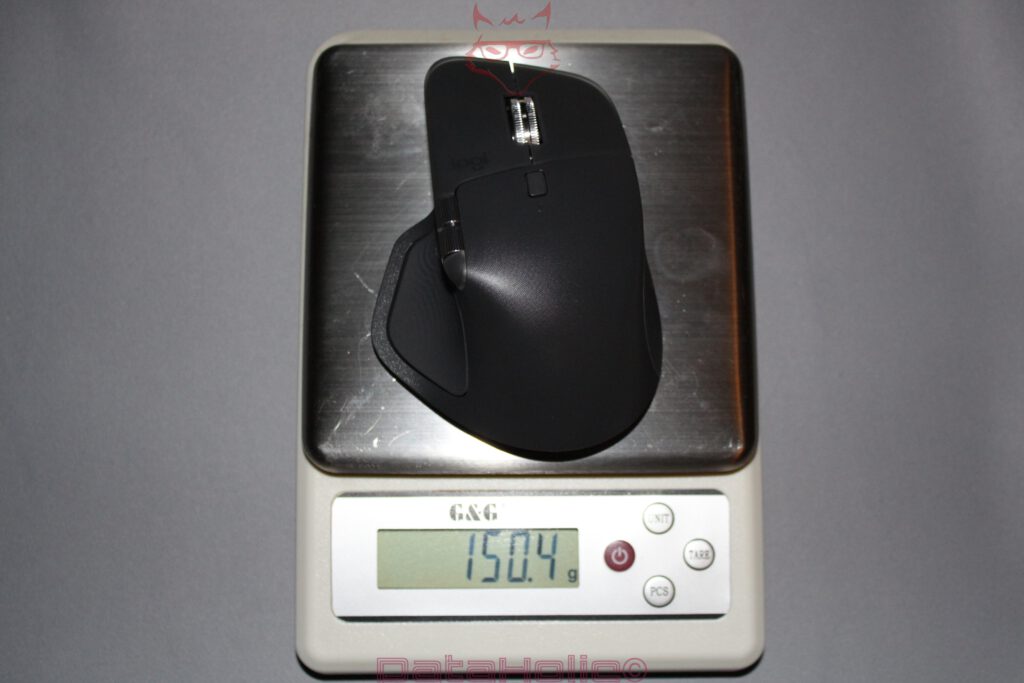
The New Action Ring with Haptics: Idea with Potential – and a Learning Curve
The most striking innovation is the Action Ring. It sits ergonomically well under the thumb and offers haptic feedback. In practice this means: context actions trigger not only on screen, but also feel like actions – a small, subtle “tap” that confirms input. This sounds trivial, but as with smartphones: a good haptic engine makes input feel more reliable.
Where does the ring shine?
- Context navigation: Window management (snap layouts), desktop switching, app switcher – all “under the thumb.”
- Timeline/track actions: In Premiere or DaVinci you can mute tracks, trim clips or set markers without moving your right hand.
- Zoom & parameters: In Figma, Lightroom or Blender the ring quickly becomes a kind of “fine adjustment dial.”
But: “With every new freedom comes new responsibility.” – Eleanor Roosevelt.
The ring is sensitive. With frequent lift-offs we repeatedly found the thumb lightly brushing it and triggering unintended actions. This is annoying – especially in programs where accidental turning or triggering costs time. It’s a design trade-off: maximum reachability vs. accidental inputs.
Practical countermeasures in everyday use:
- Train conscious thumb placement: rest the thumb slightly lower, not “hooked” on the ring.
- Where possible, choose less critical functions for the ring (e.g. zoom instead of delete).
- Activate the ring only in specific apps (if the software allows per-app settings).
With these adjustments, the ring becomes what it wants to be: a productive tool – and not a source of mishaps. Still, the conclusion is: great idea, but not perfect out-of-the-box for everyone.
Scroll Experience: Magspeed Remains King, Side-Wheel Remains a Must
The MX series is famous for two things: the main scroll wheel with its silent, buttery-smooth Magspeed mechanism and the side thumb scroll wheel. Both are delivered in familiar high quality on the MX Master 4.
- Magspeed main wheel: Millimeter-fine “detents” and ultra-fast free-spin – sprinting through 500-page PDFs while stopping precisely in table cells. Once you’ve used a Master, it’s hard to beat.
- Side scroll wheel: Scrolling horizontally through wide spreadsheets, shifting tracks in DAWs, adjusting grading parameters – it’s the second dimension of scrolling that truly boosts productivity.
Anecdote: One week with a standard mouse again – and you constantly catch yourself trying to side-scroll into nothing. Once accustomed, it becomes muscle memory.
In short: the scrolling experience remains state of the art for productive office and creator workflows.
Precision & Tracking: Calm, Clean, Reliable
On wooden desks, cloth pads, and glossy resin surfaces the MX Master 4 tracks flawlessly. Curves, fine selections, pixel-precise positioning: all without jumps or dropouts. The sensor is – Logitech-typical – optimized for high precision at moderate speeds, not frantic “flicks” like in e-sports mice.
“What gets measured gets managed.” – Peter F. Drucker
Applied to mice: What can be reliably reproduced can be planned in everyday work. That is exactly what the MX Master 4 delivers: reproducible pointer movement, minimal jitter, no surprises.
Wireless, Dongle & Device-Hopping: Flexible Like the Workday
The MX Master 4 masters two disciplines that massively ease everyday use:
- Tiny USB-C dongle: Plug in, done. Especially on desktops it remains the most stable, low-latency connection – and with USB-C finally adapter-free.
- Up to three devices: The Easy-Switch principle is still gold. Laptop, workstation, and tablet – one press, and the cursor “jumps” to the other device. Frequent switchers save minutes every day.
Compared to the MX Master 3, handling is unchanged intuitive. Compared to the MX Vertical, the Master 4 offers more multidevice comfort, since switching is blind and fast, plus side scrolling accelerates context switching.
Polling Rate & Gaming Suitability: Clearly Not an E-Sports Mouse
The hard numbers are clear: Maximum 125 Hz polling rate. That equals a scan interval of 8 ms. For office and creative tasks this is perfectly fine; precision and consistency matter more here than raw speed.
For gaming the situation is different:
- Modern monitors with 144 Hz refresh about every 6.94 ms. The mouse sends updates every 8 ms. Result: no bottleneck, but input feels less granular compared to 500/1000/8000 Hz mice.
- Subjectively, in fast aim trainers, quick flicks feel softer, less immediate. This is intentional – the MX Master 4 is not a gaming mouse.
- Conclusion: Casual gaming (Diablo, Cities, Civ, etc.)? No problem. Competitive shooters? Better go for a lighter, higher-sampling mouse.
Thus, Logitech stays true to its positioning: the Master series optimizes work efficiency, not the last millisecond in games.
Loudness & Haptics: Quiet Confidence
The buttons have a clear, medium-firm click, the main scroll wheel is very quiet, the side wheel produces a gentle hum. New and noticeable: the haptic feedback of the Action Ring. It is precise, not intrusive – you feel it without the entire thumb vibrating. After a short adjustment, it’s hard to miss the confirmation when rotating diagrams or stepping audio parameters.
Comparison with MX Master 3: Evolution – With Added Weight
Many ask: Is the upgrade worth it?
- Weight: Our measurements: MX Master 4 ~150 g, MX Master 3 ~141 g (depending on version). 9–10 g may sound minor, but it is noticeable with frequent lift-offs.
- Controls: The classics remain (Magspeed, side wheel, extra buttons). New is the Action Ring with haptics – the only true game-changer.
- Accidental inputs: With the 3, the issue was thumb button “sinking.” With the 4, it’s brushing the ring. Both require muscle memory – but the 4 has the higher input density at the thumb.
Upgrade recommendation (conclusion):
- If your productivity benefits heavily from context actions and parameter adjustments, the ring adds real value – upgrade yes.
- If you’re fully satisfied with the 3/3S, often lift the mouse, and want to minimize accidental inputs – the 3 is still very good – upgrade optional.
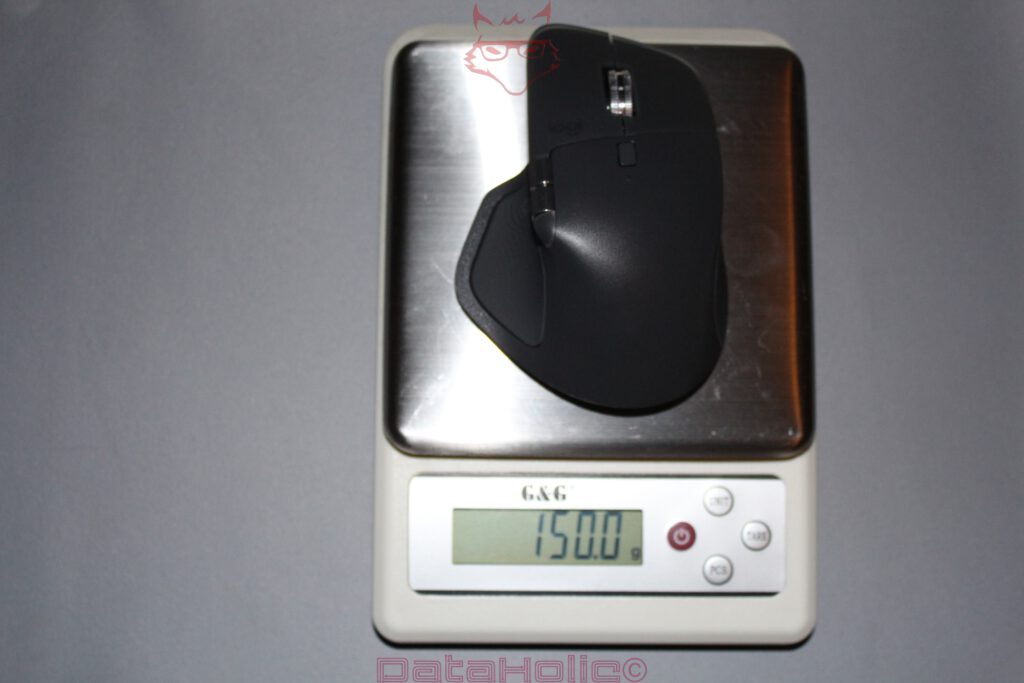
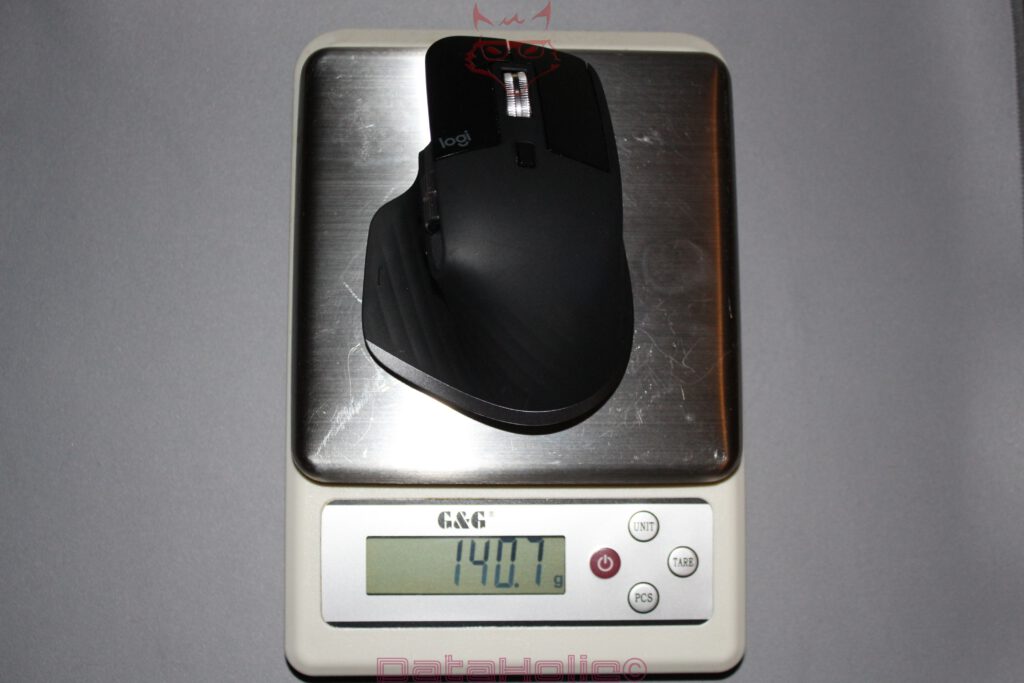
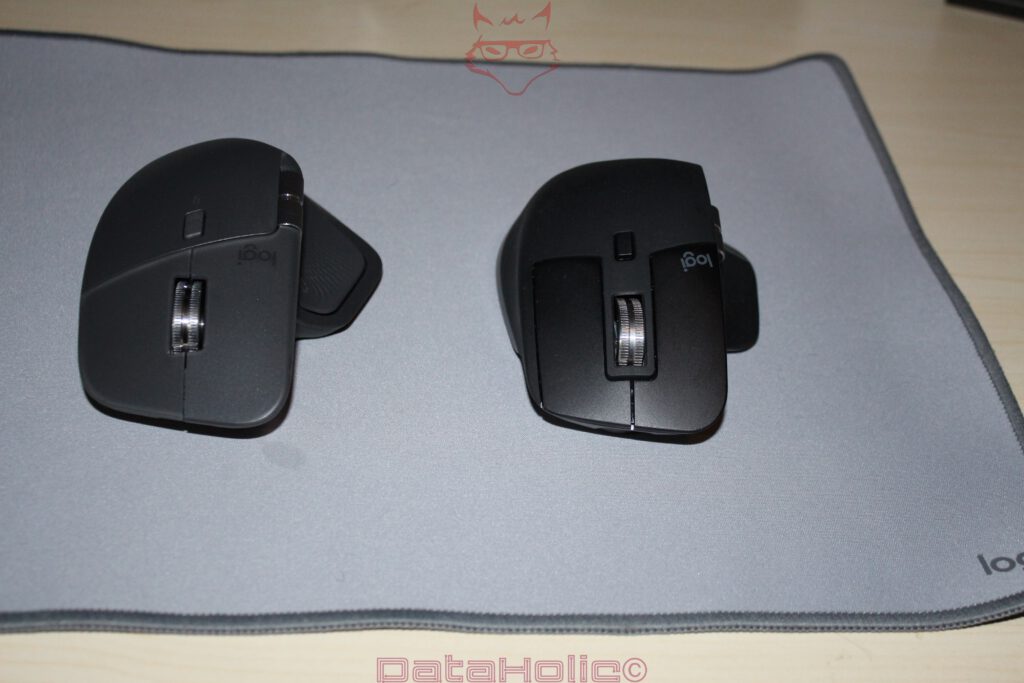
Comparison with MX Vertical: Ergonomic Specialist vs. Workflow All-Rounder
The MX Vertical remains a strong choice if wrist/forearm suffer with standard posture. Its vertical orientation reduces pronation, but at a cost:
- No side scroll wheel.
- No Action Ring.
- Fewer extra buttons overall.
Conclusion of this duel:
If you have medical reasons, the Vertical is the better choice. If your priority is multi-dimensional control in creative apps, spreadsheets, timelines, the MX Master 4 is clearly superior.
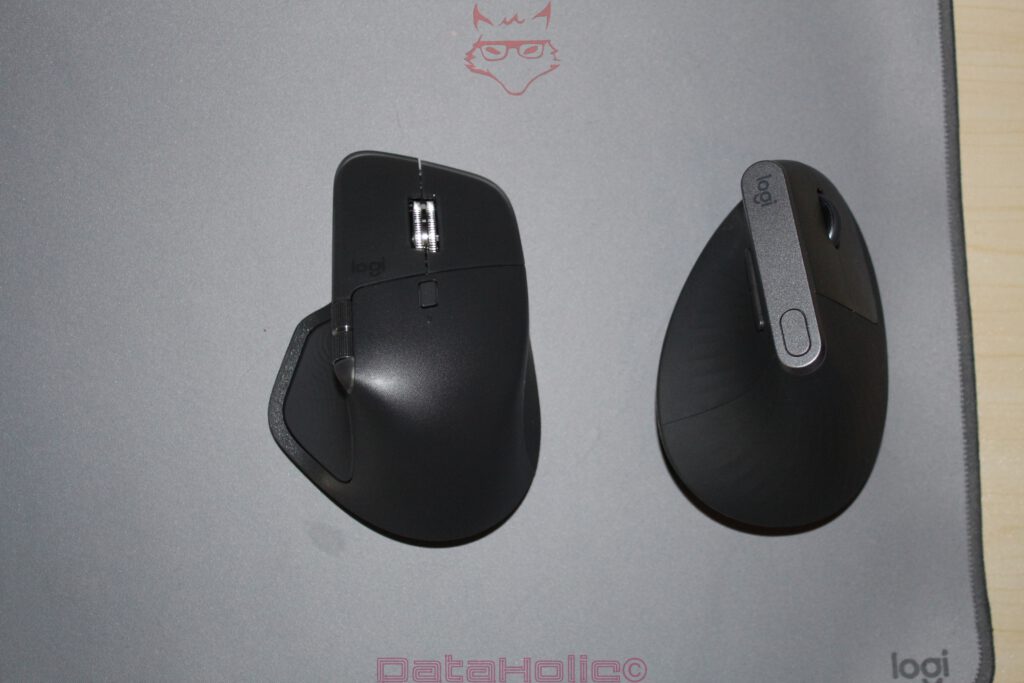
Everyday Efficiency: Small Gains, Big Effect
Productivity gains often seem unspectacular – ten seconds here, twenty there. Multiplied over hundreds of interactions a day, you get a real flow.
- Window juggling: With Action Ring & side wheel, multi-monitor work becomes frictionless.
- Text & code: Horizontal scrolling in long log lines, pixel-exact table work – fewer keyboard jumps.
- Image & video: Zooming, scrubbing, trimming – the “modular hands” (scroll wheels + ring) pay off.
Anecdote: After a week with the Master 4 we tested a standard mouse with just one scroll wheel again. Result: After three hours, the cursor felt slower – not because it was, but because the workflow stalled. This is the MX series’ quiet strength.
Weaknesses & Pitfalls: Stated Honestly
- Weight (150 g): For “lift-off users” and small pads exhausting.
- Unintentional ring activations: Happen until thumb placement is adapted.
- 125 Hz polling: Not suitable for competitive gaming.
- Too much for minimalists: Those who want only two buttons and one wheel may feel overloaded.
“Perfection is not when there is nothing more to add, but when there is nothing left to take away.” – Antoine de Saint-Exupéry
The MX Master 4 is consciously on the other side: offering a lot, so you can skip a lot – namely, extra keystrokes, shortcuts, steps.
Target Group Conclusion: Who Is the MX Master 4 For?
- Content creators, coders, analysts: Yes. Side wheel + Action Ring + Magspeed form a trio that pays off every day.
- Multi-device switchers: Yes. Three devices seamlessly controlled is a genuine gain.
- Casual gamers: Yes, as long as it’s not about highest-level reflex games.
- E-sports & low-sense FPS players: No. Weight + polling argue against it.
- Ergo-seekers with complaints: Depends – here the MX Vertical may be the better solution.
Price/Performance Assessment (without exact numbers)
Without diving into price discussions – the MX series was never cheap. You’re not buying a “pointer device,” but a work tool. And like with good mechanical keyboards, lenses, or drills: the investment pays back over time. If you use the features, you get real value. If not, you’re paying for unused capacity.
In the End: What Remains After Many Hours?
The MX Master 4 is the consistent productivity mouse: it is very well built, fits the hand excellently, scrolls outstandingly, and enhances workflows with the Action Ring. It is heavier than many competitors, not made for e-sports, and demands an adjustment period to avoid accidental ring use. Those willing to climb that learning curve gain more control and less keyboard gymnastics in daily work.
“We shape our tools, and thereafter our tools shape us.” – Marshall McLuhan
After two or three weeks you notice: the thumb instinctively seeks the ring, the side wheel already moves the timeline before you think – and the mouse is no longer just an input device, but the rhythm keeper of the workday.
Short conclusion in three sentences:
The Logitech MX Master 4 is an excellent work tool for people who create a lot and in many ways at the computer. The haptic ring concept is a true innovation, but demands discipline in assignment and hand positioning. Those who love the Master 3 will find here more of the good – plus a new dimension of thumb interaction; those who want absolute lightness and gaming suitability should look elsewhere.
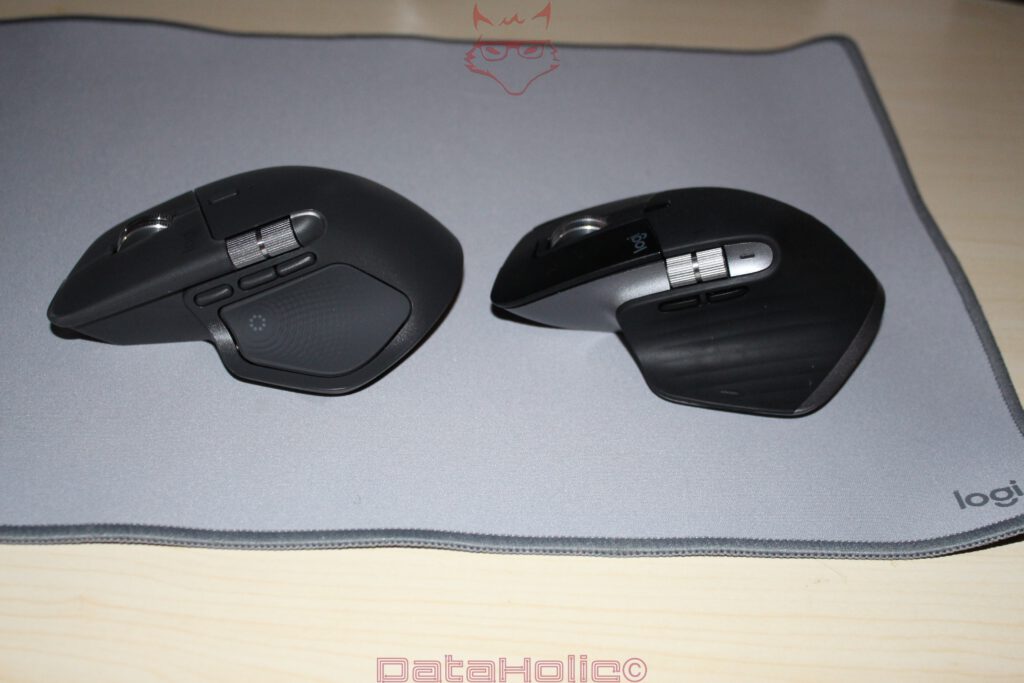
Pros & Cons (Condensed)
Pros
- First-class ergonomics and build quality
- Magspeed main wheel + side wheel = best scrolling duo in the office/creator segment
- New Action Ring with haptic confirmation: quick access to context actions
- USB-C dongle and Bluetooth, up to three devices quickly switchable
- Many well-positioned buttons, good haptics, quiet operation
Neutral
- 150 g: noticeably heavy, especially with frequent lift-off
- Unintentional ring activations possible until posture adjusts
- 125 Hz polling: clearly not for competitive gaming
- For minimalists too many controls
Decision Aid: MX Master 4 vs. MX Master 3 vs. MX Vertical
- Stay with the 3 (or 3S) if you are happy with it, lift the mouse often, and the new ring doesn’t offer essential benefits for your workflow.
- Switch to the 4 if you love context actions, work heavily with timelines/parameters, and are willing to build the thumb routine – the added value is real.
- Choose the Vertical if ergonomics is your top priority and you don’t miss the second scroll dimension or ring actions.
Technical Key Points from Our Test
- Color: Black
- Receiver: small USB-C dongle
- Multi-device: up to three devices with quick switching
- Extra controls: Action Ring with haptic feedback
- Polling rate: max. 125 Hz
- Weight: around 150 g (measured)
- Everyday note: With frequent lift-off, we occasionally had accidental ring activations
Test Environment Hardware
| Hardware | Manufacturer/Model |
|---|---|
| Mainboard | MSI MPG B850 Edge TI WiFi |
| CPU | AMD Ryzen 9 9900X |
| RAM | Crucial Pro DDR5 32 GB (2×16 GB) 6000 MHz |
| SSD | Kingston 2 TB PCIe 4.0 NVMe M.2 |
| CPU Cooler | MSI MPG Coreliquid A15 360 |
| GPU | MSI GeForce RTX 5070 12G Ventus 3X OC |
| PSU | MSI MPG A1000GS PCIe 5 |
| Case | MSI MPG Pano 110R PZ |
| Display | LC-M34-Q-C-PRO |
| Keyboard | Logitech MX Keys |
| Mouse | Logitech MX Master 4 |
| Mousepad | MSI True Gaming |
Final Conclusion
The Logitech MX Master 4 is the right mouse if you want to maximize your workflow and are willing to learn a modern thumb interaction. Its weight and 125 Hz clearly position it in the productivity segment, not in e-sports. The Action Ring is the most exciting idea since the second scroll wheel – sometimes in the way, mostly a gain. All in all, it delivers exactly what you expect from a Master: confidence in daily work, speed in thought, and calm in hand.
Note according to EU transparency regulations:
The Logitech MX Master 4 presented in this review was provided to us by Logitech as a non-binding loan for testing purposes. This is not paid advertising.
Logitech had no influence on the content, evaluation, or editorial independence of this article. All opinions expressed are based solely on our own practical experience.
We sincerely thank Logitech for providing the MX Master 4 and for the trust placed in dataholic.de.
